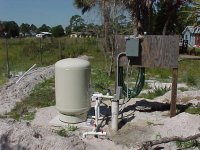Don:
Capacitor life is affected mostly 3 factors. First is voltage. There is a rated voltage for a cap. Exceeding that voltage can cause a breakdown in the dielectric (basically an insulator). This usually results in a catastrophic failure, as the breakdown allows excessively high current, and therefore heat, which causes the internal paste or liquid to build up pressure. There is a small rubber rupture type pressure relief, but if it is a major breakdown the pressure will be beyond the relief's capacity and the end of the cap typically blows out.
Second failure is due to overtemp. Wrong cap rating or too frequent high current (from frequent starts) will cause an overtemp (higher than rated average current). This results in either a catastrophic failure or a gradual degradation as the internal fluids dry out. Eventually there will be a breakdown, or it may act like it is opened and the cap is useless.
The last common failure is due to aging. As the cap ages, the fluids slowly dry out due to evaporation and a tiny bit of gas leakage (the case isn't perfectly gas tight). The aging is accelerated by thermal stress. Again the failure could be catastrophic or just a loss of function.
Your short life failure is most likely just a defective part.
paul
Capacitor life is affected mostly 3 factors. First is voltage. There is a rated voltage for a cap. Exceeding that voltage can cause a breakdown in the dielectric (basically an insulator). This usually results in a catastrophic failure, as the breakdown allows excessively high current, and therefore heat, which causes the internal paste or liquid to build up pressure. There is a small rubber rupture type pressure relief, but if it is a major breakdown the pressure will be beyond the relief's capacity and the end of the cap typically blows out.
Second failure is due to overtemp. Wrong cap rating or too frequent high current (from frequent starts) will cause an overtemp (higher than rated average current). This results in either a catastrophic failure or a gradual degradation as the internal fluids dry out. Eventually there will be a breakdown, or it may act like it is opened and the cap is useless.
The last common failure is due to aging. As the cap ages, the fluids slowly dry out due to evaporation and a tiny bit of gas leakage (the case isn't perfectly gas tight). The aging is accelerated by thermal stress. Again the failure could be catastrophic or just a loss of function.
Your short life failure is most likely just a defective part.
paul
